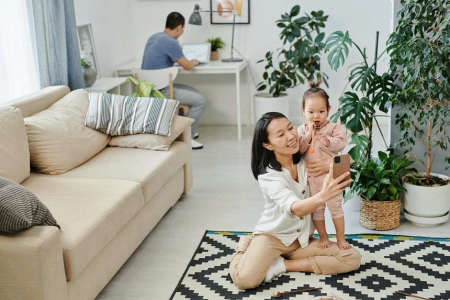Posting videos of children crying and people having meltdowns a poor idea
A viral video of a mum sharing her daughter’s reactions to her O-level results should provoke deeper thinking about a child’s right to privacy
Do we overshare the minutiae of our lives and those of others around us?
When mumfluencer Sarah Cheng-De Winne posted a TikTok video of her daughter crying after collecting her O-level results earlier this month, the backlash was immediate.
You can see her daughter walking away from the school hall in tears, while Cheng-De Winne can be heard saying: “I know you are disappointed, and I was disappointed too. But the point now is that we need to set aside a time of reflection.”
She goes on, speaking to the viewer: “Guys who just collected your O-level results, you are more than your results, all right?”
She even plugs her social media account: “Stay tuned for what happens after O levels.”
Though she tried to focus on a positive message at the end, many netizens felt she had crossed the line. Some slammed her for being disingenuous in consoling her daughter when at her most vulnerable, while others suggested she was exploiting the moment for social media likes.
@sarahxmiracle Can’t decide who’s the cutest honestly ? I love them all so much #miraclefamilie #holdup #players #coileray #momlife #momof4 #momsoftiktok #bigfamily ♬ Players - DJ Smallz 732 - Jersey Club Remix - Coi Leray
The new social media mum
To be fair, while the Singaporean singer-songwriter’s social media presence is centred around her family content, it rarely involves embarrassing moments of her children.
Her daughter was also quick to post a video rebutting the idea that she had been used as “crying bait” by her mother, which went some way to assuage concerns that the teenager had been filmed without her consent entirely.
But the episode begged the question of whether children, even in innocent and non-embarrassing situations, should be used for social media content. After all, all over the Internet, many mumfluencers (a hybrid term that refers to mums who are social media influencers), and sometimes dad influencers, have grown their following by posting pictures of their children.
“The rise of mum/mom/mommy bloggers has been a worldwide trend, with some mum bloggers now earning a significant income from their personal ‘brand’ and role as social media influencers,” wrote Dr Catherine Archer, a senior lecturer specialising in social media and strategic communication at Edith Cowan University, in 2019 in the Media International Australia journal.
One well-known example is Californian photographer Laura Izumikawa (@lauraiz), who found Internet fame by posting cute shots of her sleeping daughter Joey dressed as pop culture icons and celebrities.
Of course, influencers are not the only people to post photos of their children. Social media is awash with pictures and videos of babies and toddlers, many obviously too young to give consent or know what consent means.
Perhaps it’s easy to get caught up in the sharing frenzy. Many of us can forget about boundaries.
For one thing, where is the line? A photo of your baby in a diaper looks cute, but what about a photo of a toddler who is potty training, or a child taking a bubble bath? Such photos are ripe for exploitation and could be used in ways beyond your control.
In 2020, Ms Amanda Morgan found photos of her then six-month-old daughter taken from her Facebook and Instagram pages and shared on websites featuring paedophile content. Lurking on the Internet are all kinds of danger – voyeurs, predators and other unsavoury characters.
And since what goes on the Internet stays on the Internet, even deleting the photo after experiencing “posting remorse” does not preclude the possibility that someone has already saved the picture on his desktop and is storing it away for some nefarious use some time in the future.
How social media replaced conversations
With social media, we live a large part of our lives in a public space. We can easily sleepwalk into oversharing, without realising the content we share can compromise the privacy of others, beyond our immediate family circle.
There are people who feel compelled to post when they quarrel with their partners or while waiting for their parents to be treated at the accident and emergency department.
And when there is a stranger misbehaving or a child having a meltdown on the MRT, many automatically click record and share the video of the incident with others, with no regard for the person whose behaviour might be caused by deeper problems, a mental illness or developmental disorders.
Why then do we still continue with such thoughtless actions?
Dr Brandon Koh, an industrial-organisational psychologist and lecturer at the Singapore University of Social Sciences, has an inkling. He said in a blog post on the university’s website that social media provides people with “a shroud of anonymity, lowering the barrier to initiate or participate in public shaming”, and “magnifies the reach of such public-shaming acts to a wider audience”.
So is Cheng-De Winne comforting her daughter after her O levels a private moment requiring a more human response, not to be shared with faceless followers? Perhaps.
When dealing with stress, pain and heartbreak, time is needed for wounds to heal. Turning the experience into social media fodder can interrupt this crucial healing process.
Is it that we have forgotten how to connect with others without using our phones? If so, how will our children learn to cope with the complicated feelings they might go through in times of conflict, loss and distress – apart from picking up the instinct to pick up a phone and broadcast them to others? Would posting a Stitch to their video on TikTok help them deal with their emotional needs?
Not living for the likes
Social media has rewired the way we communicate and process our emotions, so it’s understandable that digital natives want to document moments of the day.
Indeed, from food to love to travel, we seem to be unable to live life to the fullest without our smartphones and data plans. Our camera “eats” before us as we snap photos of our lunch before digging into it, and our holidays are spent chasing Instagrammable moments.
But by living for the “Likes” and “Share” instead of for the moment, are we becoming more detached from the actual experience?
Children are being initiated into this world much sooner. A global study by international think-tank DQ Institute in 2018 showed that 85 per cent of Singapore children aged eight to 12 are active on social media. I have friends whose children as young as three or four are allowed to scroll through TikTok videos. While children cannot be totally protected from online dangers, parents can take the lead and set a good example by demonstrating healthy social media habits.
First, show how we can live outside our smartphones and social media. Take the time to help your child communicate better and learn how to have a heartfelt conversation and establish meaningful connections.
Second, when posting on social media, consider what content is worth posting, and set boundaries on what you share publicly, especially photos that feature any form of nudity or show your children or other people in vulnerable situations, and make that distinction clear to your children.
When they are old enough, get your children involved in the decision to post content. As they get older, they might develop an informed attitude towards social media, with a perspective on how to regulate their exposure, resist the pressures of comparison that come with its use, and establish a healthy relationship with it.
Dear parents, think before you post that picture or video. Instead of capturing the moment for the world, why not relish the moment and savour that rare experience of being with your daughter as she goes through a rite of passage, such as the pivotal moment when collecting O-level results? Surely, this special bonding moment is worth more than likes and shares.
*Annie Tan is a mother of two and a freelance writer who writes on women’s issues.
Get The New Paper on your phone with the free TNP app. Download from the Apple App Store or Google Play Store now



